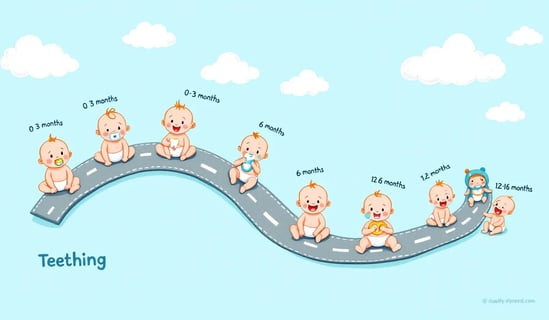How Long Does Teething Last? A Parent's Guide to Teething Timelines
Discover how long does teething last and what to expect as your baby grows. Find practical tips and insights for navigating this challenging phase. Read more!
Benny
11/14/20248 min read


How Long Does Teething Last? Tips and Timelines for Parents
How long does teething last? Teething starts around 4-6 months and goes on until 2-3 years. Here we’ll go through the stages of teething, symptoms and tips to help your baby.
Quick Facts
Teething starts at 6 months and goes on for 4-6 months until 2-3 years, all 20 primary teeth come in by 3 years.
Knowing the teething symptoms like irritability, drooling and swollen gums is important for parents to provide the right care and comfort.
Gentle gum massage, teething rings and cold objects are effective soother’s while maintaining good oral hygiene from the time the first tooth erupts is crucial for long term oral health.
The Teething Process
Teething in infants, also known as teething is a natural part of their growth and can be uncomfortable. This is the process of teeth breaking through the gums of an infant and is sometimes called teething syndrome. Babies start showing signs they are teething within the first year and signs can be visible from 5 weeks after conception. Babies start developing their first set of teeth around 6 months old.
As these teeth come through the gums, the gums can become swollen and sore and that’s teething pain. It’s important to care for the gums even before the teeth appear by cleaning them regularly to prevent food and bacteria buildup.
As we go through this stage, most often it’s the lower central incisors that appear first between 6-8 months. Knowing which teeth come next can help parents prepare and ease the discomfort their baby will go through. By 3 years, children have all 20 primary or “baby” teeth.
Knowing each stage of your child’s dental eruption and its symptoms will help you manage and ease your baby’s discomfort during this process—relieve the baby teething and the caregivers too.
When Do Babies Teethe?
Babies start teething at 6 months but can vary from one child to another. Some may start teething at 4 months while others may not show signs until they are almost a year old. Knowing the teething process will help parents manage this tough time.
The first tooth to erupt is the lower central incisor followed by the upper central incisor. As these teeth come through the gums, the gums can become swollen and sore and that’s teething pain. Parents will notice their baby becoming more irritable, drooling excessively and wanting to chew on solid objects.
To ease teething pain, parents can use teething rings or gently massage the baby’s gums with a clean finger. These will provide relief and soothe the sore gums. Teething symptoms also include changes in the baby’s sleep schedule and temporary loss of appetite.
Teething symptoms will last for a few days around the time each tooth erupts but the teething process will take about 24 months. By 2 1/2 to 3 years old, most children will have all 20 baby teeth. During this period, parents can help their baby by providing safe teething toys, using cold compresses and a calm environment.
Establishing good oral hygiene habits early is key. Before any teeth appear, parents should gently wipe the baby’s gums with a clean cloth. Once the first tooth erupts, brushing with a soft-bristled toothbrush and a small amount of fluoride toothpaste is important. Regular dental check-ups will also help maintain healthy teeth and address any issues early on.
In a nutshell, babies start teething at 6 months and the process will take about 24 months. Knowing what to expect and easing teething pain will help parents guide their baby through this tough time and establish good oral hygiene habits for a lifetime of healthy teeth.
How Long Does Teething Last?
Parents often ask how long the teething pain will last as they watch their baby go through it, which usually starts from 4-6 months and ends around 2-3 years old. By breaking it down into stages, it will feel like a series of manageable events rather than one long period.
First to appear are the lower central incisors usually at 6 months. The discomfort of each new tooth will last for about a week, from a few days before and after the tooth erupts through the gums. All 20 primary teeth including molars will usually surface by the time the child is 2 1/2 to 3 years old.
Knowing that teething varies but will subside once all baby teeth are in provides some comfort to parents during this tough period. With each new tooth that emerges during these formative years, caregivers can ease sore gums and address teething pain in infants.
Teething Symptoms
Parents should recognize the common teething symptoms to provide their child with the comfort and care they need. Sore gums are common, irritability, excessive drooling, chewing on solid objects and discomfort when new teeth start to surface.
When babies have swollen or sore gums, it usually precedes the emergence of a tooth. They may bite more often or rub their gums because of the increased pressure sensations. Excessive drooling can cause rashes around the mouth area.
Teething may also cause a slight fever and behavior like tugging the ears or rubbing the cheeks could be a sign of pain that spreads to those areas. An ears rash may also develop as a reaction to the discomfort. Some parents have noticed diarrhea during teething but this should be monitored closely as it could be a sign of more serious health issues. If you notice excessive salivation not related to teething or significant gum inflammation and redness beyond what’s normal during teething periods, consult your child’s pediatric dentist ASAP.
Teething Stages
Teething follows a predictable pattern and goes through 5 stages: lower central incisors, upper central incisors, first milk molars, canine teeth and second molar.
Knowing these stages will help you anticipate your baby’s teething symptoms and address them.
Early Teething: Lower Central Incisors
Teething is a sign of growth in an infant. Around 6-8 months, the lower central incisors are the first to erupt. The emergence of these teeth will cause excessive drooling, irritability and an intense urge to chew on objects.
To ease sore gums during this period and prevent your little one from biting on dangerous objects, provide them with safe toys or teething rings. Gently massage your baby’s gums with your clean finger or a dampened gauze pad as the central incisors surface.
Middle Teething: Canine Teeth and Molars
In the middle stage of teething, your child will experience the growth of their first molars and canine teeth. Canine teeth erupt when the child is 16-22 months old and first molars surface at 13-19 months old. The discomfort during this period will be more intense because of the larger size of the new teeth.
As they go through this stage, they may show more teething symptoms like excessive drooling, increased irritability and preference for chewing on harder objects. To ease some of the discomforts of these symptoms, provide chilled teething rings and other chewing toys.
To minimize the impact of teething on your baby’s sleep patterns, stick to a regular bedtime routine. Teething can disrupt a baby’s sleep schedule especially during the emergence of primary molars and can cause irregular sleep and discomfort. This will help counteract the sleep disturbances caused by the development of new teeth.
Late Teething: Second Molar
The emergence of the second molar is the last stage of teething, usually happening at 24-30 months. This is the final stage of their 20 primary teeth. Signs that your baby is in this stage are fussiness, gum inflammation and excess saliva.
To ease your baby’s pain, provide chilled teething rings or gently rub their gums. You can also consider over-the-counter pain relief remedies. Always consult a pediatrician before giving any medication to your child. Observe your baby closely during teething to give them the comfort and help they need.
How to Soothe a Teething Baby
Soothing a teething baby takes time and technique. You can ease their pain by gently rubbing their gums with your clean finger or a dampened gauze. Offer your baby a cold spoon to suck on or a chilled teething ring.
Teething rings and toys are designed for babies to safely chew on to ease the pressure on their sore gums. Always make sure these items are sanitized and not a choking hazard before giving to your child. If teething pain persists, you may want to consider over-the-counter remedies like acetaminophen or ibuprofen. Always consult your pediatrician first.
Giving your baby comfort during this stage also means giving them lots of hugs and attention. These simple actions can reduce teething discomfort in babies and help them through this tough time.
Caring for Your Baby’s New Teeth
Caring for your baby’s emerging teeth is important for their oral health in the long run. Before any tooth appears, start cleaning your baby’s gums with a soft cloth to remove bacteria. When the first tooth surfaces, start brushing with a tiny soft-bristled toothbrush to keep the inside of your baby’s mouth clean, protect those new teeth and prevent irritation around the baby’s mouth.
Brush twice a day, focus on the back molars where cavities are more likely to develop. By the time new teeth surface or by one year, have your child’s first dental check-up done. These early visits not only promote good oral habits but also for the dentist to monitor how your child’s primary teeth are growing.
Wait until your child can spit out fluoride toothpaste before introducing it. Around 3 years old—to prevent ingestion. Primary (first) teeth are important for oral health and overall developmental milestones of children. So starting these preventive measures early sets the foundation for lifelong healthy teeth.
When to See a Pediatric Dentist
Your baby’s oral health is important and knowing when to see a pediatric dentist during teething is crucial. If your teething baby has a fever or still showing signs of discomfort such as excessive drooling or gum swelling, have them seen by their pediatric dentist for any underlying condition.
Do not use teething remedies that contain benzocaine or lidocaine. Avoid teething necklaces and bracelets as they are a big safety hazard. For professional advice on your baby’s teething symptoms, consult their healthcare provider.
Conclusion
Teething is a big milestone in your child’s life, with different stages and signs. By understanding teething and its signs, you can give your baby lots of care and comfort. From the first tooth to the full set of molars, each is a milestone with its own challenges and joys.
Follow the tips in this guide and you’ll be able to navigate your baby through teething. Remember, teething is a short stage but proper support can make it easier for you and your baby. Enjoy these moments as they are part of your baby’s growth journey.
FAQs
When do babies teethe?
Babies start teething around 6 months old. But signs may be seen earlier than that.
How long does teething last?
Teething is from 4-6 months old to 2-3 years old, most children finish their baby teeth by 3 years old.
What are the common teething symptoms?
Irritability, excessive drooling, wanting to chew on solid objects, sore gums and slight fever.
Watch out for these symptoms and consult a pediatrician if concerned.
How to soothe my teething baby?
To soothe your teething baby and care for their erupting teeth, rub their gums with your clean finger or wet gauze, offer a cold spoon or chilled teething ring and provide safe teething toys. Start brushing their teeth as soon as they appear to establish good oral habits early on.
These will help ease their discomfort and promote healthy tooth growth.
When to see a pediatric dentist?
See a pediatric dentist if your baby has a fever, still teething symptoms, excessive drooling or gum swelling.
Fix this ASAP to protect your child’s oral health.





